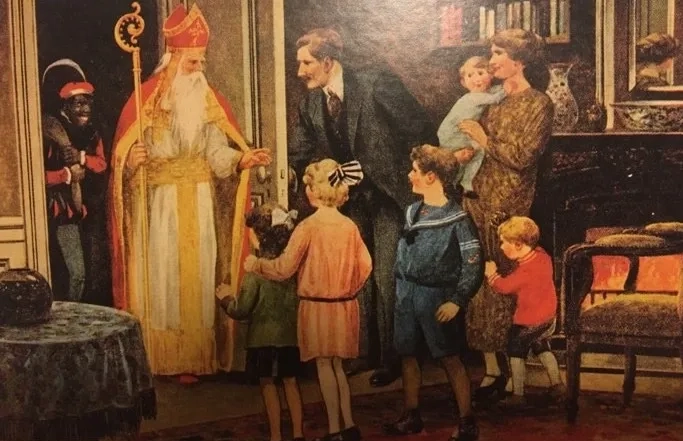It’s that wonderful time of year when Christmas is right around the corner. As people wait for 2020 to finally end (seriously, please just end), JustFocus Weekly decided to look at how people around the globe celebrated this special holiday.
Starting this series of articles is The Netherlands!
While the Dutch also celebrate Christmas on the 24th and 25th of December, there is another day that stands out the most. On the 5th of December, Sinterklaas comes to visit with presents. Some of you may have heard of Santa Claus, well Saint Nicholas, or ‘Sinterklaas’ as he is known in Dutch, was the original scarlet gift-giver.
The Dutch Sinterklaas Myth:
Sinterklaas is a Turkish saint coming from Spain on a boat with his white horse and his helpers known as Pieten. He arrives in the Netherlands two weeks before the 5th of December in a big parade. There is music, people dressed as Piet, handing out sweets and special ginger biscuits known as pepernoten. He is said to travel the Netherlands until the 5th of December, leaving sweets and special biscuits in children’s shoes each Saturday night until then. Children, in turn, leave out carrots for his horse, drawings, and sing songs for Sinterklaas.

The 5th of December is known as Sinterklaasavond (Saint Nicholas Eve) or pakjesavond (presents night). Children are told that Sinterklaas goes from roof to roof on top of his horse, and his helper Piet goes down the chimney to leave the presents by the fireplace. Sometimes, children will hear a loud knock on the door and find a sack of presents on their doorstep. They are also told that the Pieten have Sinterklaas’s Big Red Book that has the naughty and nice list that they check nonstop. If children have been naughty, the Piets put the child in a sack and take them back to Spain for a year to discipline them.
In recent years, there has been controversy regarding the ‘Zwarte Piet‘ (Black Peter) character due to the racist history of the character. Originally, Dutchmen and women would put on thick black face paint to represent Black Peter. Today, the helpers are simply known as ‘Roet Piet’ (Sooty Peter) or just Pieten. This is because the Dutch are replacing the black paint with soot patches to represent going down a chimney. However, this newer version of Piet has divided opinion amongst the Dutch.
On the 6th of December, Sinterklaas boards a steamboat and returns to Spain.
Dutch Traditions:
During the evening of the 5th of December, Sinterklaas parties are held by Dutch families. They will eat sweets, play games, tell jokes, and enjoy being with family. There is even a special news show broadcast to celebrate Sinterklaas.
One of the traditions of pakjesavond is that family members will write poems for one another to be read out loud.
Frank (28) loves his Sinterklaas traditions. “They are special poems addressed to people written in limerick style. They are meant to be jokes about the person they are destined for, like a little roast or hinting about their gift. The aim is to be as funny as possible,” he explains while making his papier-mâché gift.
Papier-mâché gifts are also another part of the pakjesavond experience. Called ‘surpreses’ or surprises, these cardboard gifts are meant to be jokes to give to friends and family. If a person says they wanted a bike, they could receive a papier-mâché or cardboard bike cutout instead. Or, in Frank’s case, a cardboard bee.

Once Sinterklaas has passed, Christmas trees are put up and radio stations play popular Christmas songs. Some families will celebrate both Sinterklaas and Christmas; others, one or the other.
On the 24th of December, ‘Kerstman’ or Father Christmas comes from Lapland to give more gifts to the children.
Dutch Christmas Food:
“Our Christmas meals on December 24th and 25th are very similar to America’s. But that depends on the family, of course. We don’t really have special meals for Sinterklaas. But we do have great sweets,” says Frank excitedly.
If you want to get into a fight with a Dutchman, start a debate on either Zwarte Piet or Pepernoten.
In the Netherlands, there are two types of delicious biscuits made of ginger and spices called Pepernoten and Kruidnoten. One type is circular, and one type is square. The (hilarious) controversies arise over which type should be called Pepernoten and when a shopkeeper can start selling them. If you want to rile up the Dutch, start offering them in August and see what happens. It is generally accepted that Kruidnoten are the famous circular biscuits, while Pepernoten are the lesser-known square ones.
Another special treat is the Chocolate letter. Used as a stocking stuffer, a person will receive a chocolate letter of their initials. Marzipan, mulled wine, and hot chocolate are also very popular at this time of year.

So if you ever spend Christmas in the Netherlands, get yourself a bag of kruidnoten, a chocolate letter, and a surprise. Most important of all, don’t forget these magic words:
Prettige Kerst!




Comments (0)